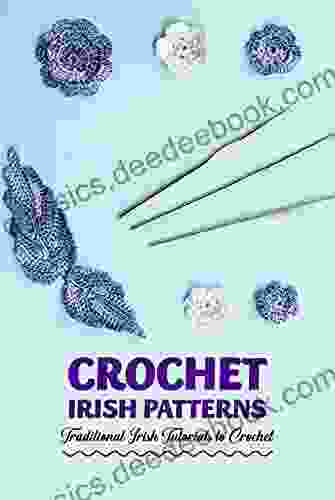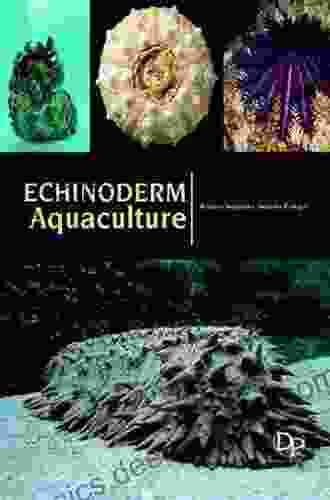Echinoderm Aquaculture: A Comprehensive Guide to Farming Sea Stars, Sea Urchins, and Sea Cucumbers

Echinoderms, the spiny-skinned invertebrates that include sea stars, sea urchins, and sea cucumbers, are increasingly becoming a popular target for aquaculture. Their nutritional value, unique flavors, and growing demand in the culinary market make them an attractive option for commercial farming. This comprehensive guide will provide an overview of echinoderm aquaculture, covering hatchery techniques, nutrition, disease management, marketing strategies, and future prospects.
5 out of 5
| Language | : | English |
| File size | : | 19110 KB |
| Text-to-Speech | : | Enabled |
| Screen Reader | : | Supported |
| Enhanced typesetting | : | Enabled |
| Print length | : | 362 pages |
| Lending | : | Enabled |
Hatchery Techniques
Successful echinoderm aquaculture начинается with a reliable hatchery. Hatcheries provide a controlled environment for egg incubation and larval rearing, ensuring high survival rates and consistent production. Various hatchery techniques have been developed for different echinoderm species, but general principles can be summarized as follows:
- Broodstock management: Selecting healthy and mature broodstock is crucial for successful reproduction. Broodstock animals are maintained in tanks or raceways with optimal water conditions and fed a nutritious diet.
- Spawning induction: Spawning can be induced by various methods, such as thermal shock, hormone injections, or electrical stimulation. Artificial fertilization is commonly used to ensure high fertilization rates.
- Egg incubation: Fertilized eggs are incubated in tanks or jars with gentle aeration and water circulation. Egg development is closely monitored to determine hatching time.
- Larval rearing: Echinoderm larvae are planktonic and require specialized diets. Larval rearing involves providing a constant supply of food, maintaining water quality, and monitoring growth and survival rates.
- Metamorphosis: Larvae undergo metamorphosis to develop into juvenile echinoderms. Metamorphosis is triggered by various environmental cues, such as light, temperature, or food availability.
Nutrition
Echinoderms have specific nutritional requirements that vary depending on their species and life stage. Understanding their nutritional needs is essential for optimizing growth and survival in aquaculture systems.
- Juvenile echinoderms: Juveniles typically feed on a diet of microalgae, such as diatoms and green algae. Live preys, such as rotifers and brine shrimp, can also be incorporated into their diet.
- Adult echinoderms: Adult echinoderms have diverse feeding habits and can consume a range of food items, including algae, invertebrates, and detritus. Providing a balanced diet that meets their nutritional requirements is crucial for maintaining health and growth.
Disease Management
Disease outbreaks can pose significant challenges to echinoderm aquaculture. Common diseases in echinoderms include bacterial infections, viral infections, and parasitic infestations. Implementing effective disease management strategies is crucial for preventing and controlling disease outbreaks.
- Disease prevention: Prevention is the best approach to disease management. Maintaining optimal water quality, providing a nutritious diet, and avoiding overcrowded conditions can help reduce the risk of disease outbreaks.
- Disease diagnosis: Early and accurate diagnosis is essential for effective disease management. Microscopic examination, histological analysis, and molecular diagnostics can be used to identify specific pathogens.
- Disease treatment: Treatment options for echinoderm diseases are limited, but antibiotics, antifungal medications, and antiparasitic drugs can be used to control outbreaks. Vaccination and immunostimulants can also be used to enhance disease resistance.
Marketing Strategies
Successful echinoderm aquaculture depends not only on production efficiency but also on effective marketing strategies. Target markets, pricing strategies, and distribution channels need to be carefully considered to ensure profitability.
- Target markets: Identifying the target markets for echinoderms is crucial. High-end restaurants, sushi bars, and Asian markets are potential target markets for premium-quality echinoderms.
- Pricing strategies: Pricing echinoderms competitively is essential for market success. Factors to consider include production costs, market demand, and competition.
- Distribution channels: Establishing reliable distribution channels is vital for getting echinoderms to the market. Live transport, chilled transport, and frozen products are common distribution methods.
Future Prospects
Echinoderm aquaculture has a bright future with increasing demand for these marine delicacies. However, there are several challenges that need to be addressed to ensure sustainable growth:
- Environmental sustainability: Echinoderm aquaculture must be conducted in an environmentally sustainable manner to minimize its impact on the marine ecosystem.
- Disease management: Ongoing research and development are needed to improve disease management practices and reduce disease outbreaks.
- Product diversification: Exploring new product forms, such as processed echinoderm products or value-added ingredients, can increase market opportunities.
Echinoderm aquaculture has the potential to provide a sustainable source of high-quality food while also supporting coastal communities and economies. By implementing best practices in hatchery techniques, nutrition, disease management, marketing strategies, and future research, we can ensure the sustainable growth of this emerging industry.
5 out of 5
| Language | : | English |
| File size | : | 19110 KB |
| Text-to-Speech | : | Enabled |
| Screen Reader | : | Supported |
| Enhanced typesetting | : | Enabled |
| Print length | : | 362 pages |
| Lending | : | Enabled |
Do you want to contribute by writing guest posts on this blog?
Please contact us and send us a resume of previous articles that you have written.
 Book
Book Page
Page Chapter
Chapter Text
Text Story
Story Genre
Genre Reader
Reader Paperback
Paperback E-book
E-book Magazine
Magazine Newspaper
Newspaper Paragraph
Paragraph Bookmark
Bookmark Shelf
Shelf Bibliography
Bibliography Foreword
Foreword Preface
Preface Synopsis
Synopsis Bestseller
Bestseller Library card
Library card Memoir
Memoir Encyclopedia
Encyclopedia Dictionary
Dictionary Thesaurus
Thesaurus Narrator
Narrator Borrowing
Borrowing Archives
Archives Periodicals
Periodicals Study
Study Lending
Lending Journals
Journals Rare Books
Rare Books Special Collections
Special Collections Interlibrary
Interlibrary Literacy
Literacy Study Group
Study Group Thesis
Thesis Book Club
Book Club Theory
Theory Textbooks
Textbooks Patricia Greathouse
Patricia Greathouse Phillip James Grismer
Phillip James Grismer Svenja O Donnell
Svenja O Donnell Elizabeth Salas
Elizabeth Salas Pratish Mistry
Pratish Mistry Roger Williams
Roger Williams Gopal K Kanji
Gopal K Kanji Neil Gould
Neil Gould Derek Slaton
Derek Slaton Veronica Eden
Veronica Eden Santa Montefiore
Santa Montefiore Julia Kent
Julia Kent Mother Bee Designs
Mother Bee Designs Phaedra Patrick
Phaedra Patrick Sangeet Kumar
Sangeet Kumar George Neeb
George Neeb Pawlet Brookes
Pawlet Brookes Mhairi Mcfarlane
Mhairi Mcfarlane Judy Duarte
Judy Duarte Brian Winston
Brian Winston
Light bulbAdvertise smarter! Our strategic ad space ensures maximum exposure. Reserve your spot today!

 Samuel WardThe Ultimate Guide to the Jazz Philharmonic String Orchestra Teacher Manual:...
Samuel WardThe Ultimate Guide to the Jazz Philharmonic String Orchestra Teacher Manual:... Dion ReedFollow ·15.1k
Dion ReedFollow ·15.1k Chance FosterFollow ·17.2k
Chance FosterFollow ·17.2k Lawrence BellFollow ·7.3k
Lawrence BellFollow ·7.3k Mikhail BulgakovFollow ·3.3k
Mikhail BulgakovFollow ·3.3k Devin CoxFollow ·15.5k
Devin CoxFollow ·15.5k Harrison BlairFollow ·10.4k
Harrison BlairFollow ·10.4k Aleksandr PushkinFollow ·3.3k
Aleksandr PushkinFollow ·3.3k W.B. YeatsFollow ·5.3k
W.B. YeatsFollow ·5.3k

 Earl Williams
Earl WilliamsThe Texas Colorado River: A Vital Resource for Central...
The Texas Colorado River is an...

 Robert Heinlein
Robert HeinleinCrochet Irish Projects For Beginners: A Comprehensive...
Crochet Irish lace, with its intricate...

 Mason Powell
Mason PowellAyahuasca Awakening: A Comprehensive Guide to...
Ayahuasca is a...

 Glenn Hayes
Glenn HayesPrice Forecasting Models for Dawson Geophysical Company...
In the realm of financial...

 Emanuel Bell
Emanuel BellStressors in the Marine Environment: A Comprehensive...
The marine environment is facing a...
5 out of 5
| Language | : | English |
| File size | : | 19110 KB |
| Text-to-Speech | : | Enabled |
| Screen Reader | : | Supported |
| Enhanced typesetting | : | Enabled |
| Print length | : | 362 pages |
| Lending | : | Enabled |












